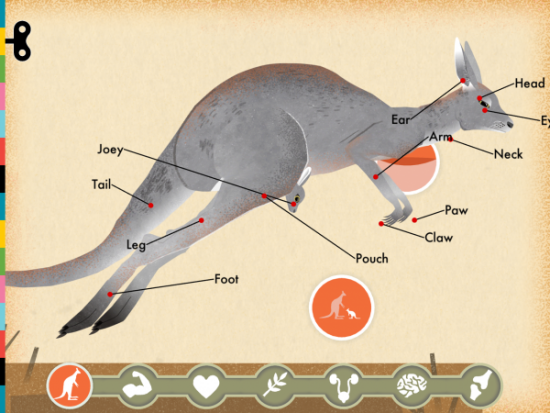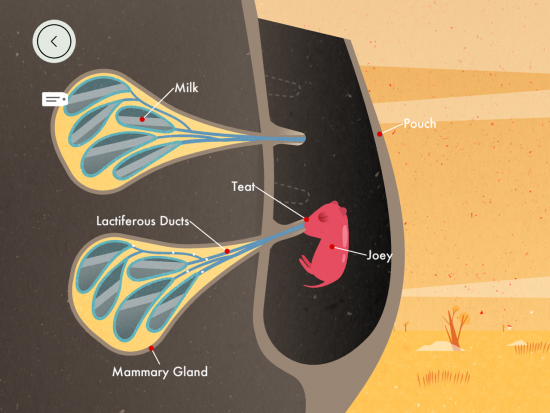2018 School Spending Survey Report
What Do a Bat and Kangaroo Have in Common? | Find Out in Tinybop's "Mammals"
A new tool to engage kids in the sciences that's informative, interactive, and easy to navigate.

Screen from Mammals (Tinybop, Inc.) illus. by Wenjia Tang
Using the interactive Mammals (Tinybop Inc. iOS, $2.99; PreK-Gr 2) viewers can explore the attributes of an African elephant, a Bengal tiger, a brown bat, a sloth, and a red kangaroo. Options allow for a look inside each creature’s skeletal, muscular, nervous circulatory, respiratory, and digestive systems, and for two of the animals, their urogenital systems. While exploring the digestive system of each mammal viewers experiment with menu options to determine the foods each animal prefers. (The elephant rejects meat but consumes vegetation, while a tiger has an appetite for meat and rebuffs vegetation, etc.) Herbivores, carnivores, and omnivores are represented in the group, and astute observers may notice that the stomachs differ. Food intake eventually produces waste, which young viewers will no doubt delight in causing to happen. Urogenital systems depict an elephant fetus and a kangaroo's joey nursing. Kids can also explore the animals’ unique traits: the bat employs echolocation to determine what is flying within its range; the tiger has retractable claws, and so on. Other features allow viewers to investigate how each creature sees, to stage a race between two mammals to compare speeds, to find out how animals react to tickles or stings, and to examine fur up close. A look at a skeletal system depicts how it hold ups different body parts, but with a tap to the screen viewers can disassemble it and put it back together again. Both the app’s visuals and animations are excellent. The audio provides minimal sound effects such as chewing or running. There is no text, but labels in five languages are available. The free, online handbook (available in eight languages) is a useful tool for adults to prompt discussions with kids about their observations and contains a wealth of additional information on each animal. VERDICT A fabulous tool to engage kids in the sciences that's both engaging and easy to navigate.—Debbie Whitbeck, formerly of West Ottawa Public Schools, Holland, MI
Screen from Mammals (Tinybop, Inc.) illus. by Wenjia Tang
For additional app reviews, visit School Library Journal's dedicated app webpage.
RELATED
RECOMMENDED
CAREERS
The job outlook in 2030: Librarians will be in demand
CAREERS
The job outlook in 2030: Librarians will be in demand
ALREADY A SUBSCRIBER? LOG IN
We are currently offering this content for free. Sign up now to activate your personal profile, where you can save articles for future viewing






Add Comment :-
Be the first reader to comment.
Comment Policy:
Comment should not be empty !!!